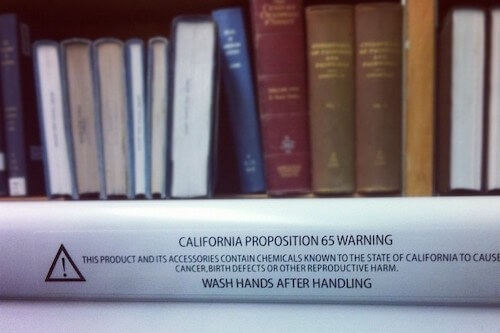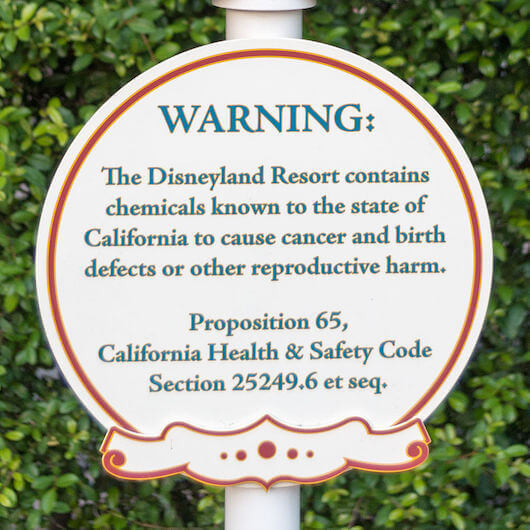California is the most populous U.S. state, and its economy is also the nation’s largest. With a GDP of over $3 trillion USD, on its own, it would be the fifth-largest economy in the world.
The state is a large market for consumer product importers, and if you sell products there, you need to understand a key piece of legislation — California Proposition 65.
Here we talk about what Prop 65 is and how it affects consumer goods importers selling their products in California. We also discuss some tips for handling compliance with this regulation.
Table of Contents
What is California Prop 65?

Image Source: Ben Chun on Flickr
Also known as the “Safe Drinking Water and Toxic Enforcement Act of 1986,” it is a voter initiative with the goal of protecting residents of the state from harmful chemicals. One way it aims to accomplish this is through the use of labeling requirements.
The Office of Environmental Health Hazard Assessment (OEHHA) maintains a list of chemicals, both naturally occurring and synthetic. The chemicals on the list are those known by the state of California to cause cancer, birth defects, or other reproductive harm. Currently, it contains over 900 chemicals and is updated every year.
The initiative does not prohibit you from selling products with these chemicals. However, if your products have an amount that exceeds “safe harbor levels,” they need to come with a “clear and reasonable” warning label. The label should have an exclamation point inside a yellow triangle, followed by a warning message.
For example:
⚠️ WARNING: This product can expose you to chemicals including [name of one or more chemicals], which is [are] known to the State of California to cause cancer and birth defects or other reproductive harm. For more information go to www.P65Warnings.ca.gov.
What Products Does Prop 65 Apply To?

If you want to know what products are affected by Prop 65, you should keep in mind that the applicability of the regulation depends on the chemicals in products rather than product type. That said, certain types of products tend to contain certain types of chemicals.
To determine whether your product has one of the chemicals on the Prop 65 list, you should reach out to a testing lab. The lab can advise you on the types of tests to conduct and provide general Prop 65 guidance. At Insight, we have relationships with several good labs and can connect you if needed.
Additionally, Prop 65 only applies to companies with ten or more employees, so it does not apply to you if your company is still below this number.
Prop 65 – List of Products (Examples Only, Not Exhaustive)
Below are some examples of consumer products and some chemicals they might contain. View the CA Prop 65 Chemicals List and Fact Sheets for more detailed information. Again, the applicability of the regulation generally depends on the chemicals a product contains as opposed to the product type.
▶ Furniture Products

Examples:
- Flame retardants may be added to foam or textiles.
- Formaldehyde may be found in particleboard, paints, lacquers, and coatings.
- Phthalates may be added to plastics for flexibility.
▶ Garments and Apparel

Examples:
- Lead and Cadmium are sometimes present in zippers, snaps, buttons, polymers, and coatings.
- Phthalates may be found in PVC, vinyl, screenprints, and rubberized buttons.
▶ Building Materials

Examples:
- Formaldehyde may be found in foam and fiberglass insulation.
- Crystalline silica may be released when working with drywall.
- Wood dust may be released when working with wood products.
▶ Bags and Accessories

Examples:
- Lead may be found in PVC or leather bags and luggage.
- Phthalates may be found in bags, wallets, or soft plastic jewelry.
▶ Household Appliances

Examples:
- Benzene and carbon monoxide may be emitted by products such as ranges, dryers, and water heaters.
- Flame retardants and Phthalates may be present in casings, electrical parts, and cables.
▶ Juvenile Products

Example:
- Flame retardants and Phthalates may be found in plastic toy coatings.
So if your product contains these chemicals in an amount above the safe harbor level, what kind of label do you need?
Prop 65 Warning Label Examples
Many people have criticized Prop 65 for being poorly drafted. According to a Los Angeles Times article, “The profusion of warnings stemming from California’s landmark consumer safety law has left shoppers over-warned, under-informed and potentially unprotected.”

A Prop 65 Warning at Disneyland – Source: Patrick Pelletier on Wikimedia Commons
Initially, the requirements for Prop 65 warning labels were particularly generic, with labels like the one below considered acceptable. You’ll note that it doesn’t even mention what the chemical in the product might be.
⚠️ WARNING: This product contains a chemical known to the State of California to cause [cancer / birth defects or other reproductive harm].
In 2018, new guidance went into effect, requiring that companies list more specific chemicals in the warning. You can find official requirements from the California Code of Regulations here. Please see these regulations for specific guidance.
If your product contains a chemical known to cause cancer, you might use the following warning, for example.
⚠️ WARNING: This product can expose you to chemicals including [name of one or more chemicals], which is [are] known to the State of California to cause cancer. For more information go to www.P65Warnings.ca.gov.
To determine whether your product contains chemicals that would require a label, please contact a testing lab.
How is CA Prop 65 Enforced?

Prop 65 is enforced through the state Attorney General’s Office, district attorneys, and city attorneys. Individuals can also file lawsuits against businesses, and many private attorneys make a practice out of looking for non-compliant products.
A “60-Day Notice” will be issued to you, and if a settlement is not reached before that time, you can be taken to court. The fine for a non-compliant product is $2,500 per day, but cases often settle as trials can be costly.
There are even some litigators who purposefully seek out products that may actually be compliant. But, as many companies do not want to deal with an expensive court case, their goal is to get them to settle.
If you receive a notice, you should seek the advice of an attorney specializing in matters related to CA Prop 65. You should also consider conducting lab tests to help assess the validity of the claims against you.
How Do You Ensure Compliance With Prop 65?

To ensure compliance with Cal Prop 65, consider working with an accredited testing lab to conduct an assessment. This way, you can get an idea of whether warning labels are required for your product.
There are no specific requirements in the California Code for testing your product. However, by testing it, you can determine if it contains specific chemicals from the Prop 65 list.
If you’re thinking about conducting lab tests, we recommend downloading the following free guide.
Lab Testing: How to Get Started
As a consumer product importer, lab tests help you ensure that your products are compliant with regulations in the country of importation.
We’ve put together this guide to help you get started with lab testing so that you can make your products available for sale sooner rather than later. Avoid fines and customs issues by starting off on the right foot.
Note: This article was first published in September of 2019 and has since been updated.





0 Comments